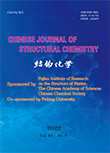Controllable Synthesis, Polar Behavior and Photoelectric Properties of BiOCl Microplates
LI Li-Xin, CHEN Chen, LI Zi-Hao, WANG Fei-Fei*, LIU Yun* and YI Zhi-Guo*
Chin. J. Struct. Chem. 2022, 41, 2203077-2203084 DOI: 10.14102/j.cnki.0254-5861.2011-3352
March 15, 2022
bismuth oxychloride, photoelectric, microplate, hydrothermal method
ABSTRACT
Bismuth oxychloride (BiOCl)
square microplates were prepared via a facile hydrothermal method. The X-ray
diffraction patterns of the samples reveal a tetragonal BiOCl phase, and the
scanning electron microscopy images show plate-like structures with large
lateral size of 3~6 μm and thickness in the range of 100~300 nm. The effects of surfactant, reaction
temperature and duration on the morphology of BiOCl powders are systematically
investigated. The polar behavior of a BiOCl single-crystalline microplate is
examined by using piezoresponse force microscopy evidenced over 80 pm
displacement under 40 V bias voltage. In addition, the photoelectric
performance of the BiOCl microplates is evaluated by using electrochemical
workstation with three-electrode system, and large photocurrent densities (over
0.5 μA/cm2) and fast
photoresponse (0.7~1.1 s) are detected by applying both 365 nm
monochromatic light and sunlight illumination. The surface potential changes of
BiOCl microplate under different light condition, characterized by in-situ Kelvin probe force microscopy,
further verify the separation ability of the photo-induced charge carriers.
These findings would be beneficial for further design photocatalytic and
piezocataly- tic materials.








